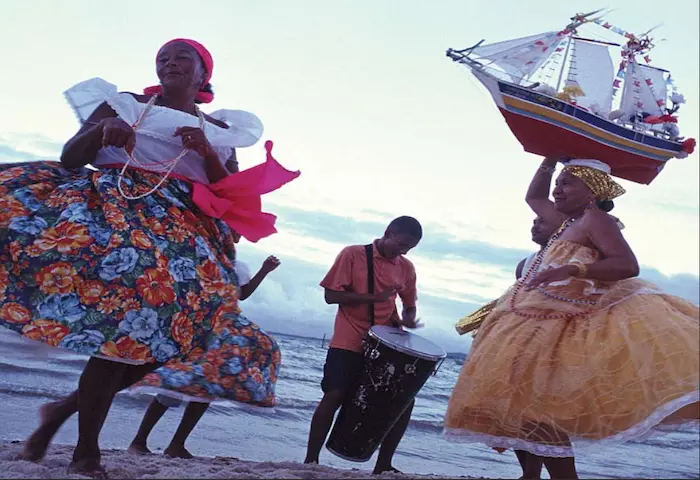Samba is a lively, rhythmic dance and musical genre originating from Brazil. This music genre is renowned for its rich cultural history and vibrant energy, captivating audiences worldwide. Samba‘s roots trace back to the African slaves brought to Brazil, evolving into the diverse and dynamic style celebrated today.
I. Historical Background
1. African Roots
Samba’s history begins in Africa. Enslaved Africans were transported to Brazil by Portuguese colonizers starting in the 16th century. They brought their music, rhythms, and dances, forming the foundation of what would become samba. These African rhythms merged with Portuguese and indigenous Brazilian elements, creating a unique sound.
2. Birth in Rio de Janeiro
Samba as a distinct genre emerged in Rio de Janeiro in the early 20th century. Urbanization and the migration of former slaves to Rio’s favelas (slums) facilitated the blending of African rhythms with European musical forms. This fusion created a new sound that resonated with the city’s diverse population.
II. Evolution of Samba
1. Early Samba
Early samba, known as “samba de morro” or “hill samba,” originated in Rio’s favelas. It was characterized by its simple instrumentation, often featuring percussion instruments like the pandeiro, tamborim, and cavaquinho. The music reflected the daily lives and struggles of the Afro-Brazilian community.
2. Samba Schools and Carnival
Samba’s popularity grew, leading to the formation of samba schools (escolas de samba). These community organizations played a crucial role in preserving and promoting samba music. They participated in Rio’s annual Carnival, a massive celebration featuring elaborate parades and competitions. Carnival became synonymous with samba, showcasing its energy and cultural significance.
3. Bossa Nova and Modern Influences
In the late 1950s, bossa nova, a jazz-influenced style of samba, emerged. Artists like João Gilberto and Antonio Carlos Jobim popularized this genre, blending samba rhythms with softer, more melodic sounds. Bossa nova gained international acclaim, introducing samba to a global audience.
III. Key Elements of Samba Music
1. Rhythm and Percussion
Samba’s rhythm is its defining feature. The syncopated beats and intricate percussion create an infectious, danceable groove. Traditional samba ensembles often include instruments like the surdo (bass drum), tamborim, agogô (double bell), and cuíca (friction drum). These instruments produce the complex rhythms that make samba so captivating.
2. Melody and Harmony
While rhythm is central to samba, melody and harmony also play essential roles. Samba melodies are often simple and catchy, making them easy to sing along to. The harmony typically involves a progression of chords that complement the rhythm, creating a rich musical texture.
3. Dance
Samba is not just music; it is also a dance. The dance style associated with samba is energetic and lively, characterized by quick footwork and rhythmic movements. Samba dancers often wear colorful costumes, especially during Carnival, adding to the visual spectacle of the music.
IV. Prominent Samba Artists
1. Carmen Miranda
Carmen Miranda, a Brazilian singer, and actress, helped popularize samba internationally in the 1930s and 1940s. Her vibrant personality and iconic fruit-laden headpieces made her a symbol of Brazilian culture. Miranda’s performances introduced samba to a global audience, cementing its place in the world music scene.
2. João Gilberto and Antonio Carlos Jobim
João Gilberto and Antonio Carlos Jobim were pivotal figures in the bossa nova movement. Gilberto’s innovative guitar playing and Jobim’s sophisticated compositions brought samba to new heights. Their collaboration on songs like “The Girl from Ipanema” became timeless classics, blending samba with jazz influences.
3. Martinho da Vila and Zeca Pagodinho
Martinho da Vila and Zeca Pagodinho are contemporary samba artists known for their contributions to the genre. Martinho’s music often reflects social and political themes, while Zeca’s laid-back style captures the essence of traditional samba. Both artists have played significant roles in keeping samba alive and relevant in modern Brazil.
V. Cultural Significance
1. National Identity
Samba is deeply ingrained in Brazilian national identity. It represents the country’s diverse cultural heritage and history. Samba’s rhythms and melodies evoke a sense of pride and unity among Brazilians, transcending social and economic barriers.
2. Social Commentary
Samba has also served as a form of social commentary. The lyrics often address issues such as poverty, inequality, and political struggles. Through samba, artists can express their views and connect with their audience on a profound level.
3. International Influence
Samba’s influence extends far beyond Brazil’s borders. It has inspired various music genres worldwide, from jazz to pop. International artists have incorporated samba rhythms and elements into their music, demonstrating the genre’s versatility and global appeal.
VI. The Role of Samba in Brazilian Festivals
1. Carnival
Rio de Janeiro’s Carnival is the most famous samba festival globally. It features spectacular parades, vibrant costumes, and electrifying performances by samba schools. Carnival is a time when Brazilians and tourists alike come together to celebrate samba and Brazilian culture.
2. São João Festival
The São João Festival, celebrated in June, is another significant event where samba plays a central role. This festival, particularly popular in northeastern Brazil, features traditional samba music and dances, highlighting the genre’s regional variations.
See Also: Which Open Tuning is Best for Country Music?
VII. Conclusion
Samba music is the heartbeat of Brazil, a genre that encapsulates the country’s rich cultural heritage and history. Originating from African rhythms and evolving in the favelas of Rio de Janeiro, samba has become a symbol of Brazilian identity. Its infectious rhythms, captivating melodies, and vibrant dances continue to enchant audiences worldwide. Samba’s legacy lives on through the contributions of legendary artists and the continued celebration of Brazilian festivals, ensuring its place as one of the world’s most beloved music genres.

